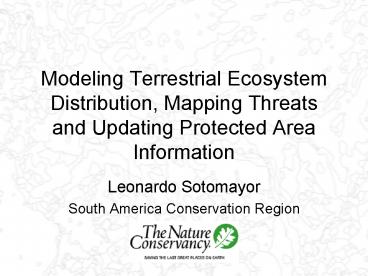Modeling Terrestrial Ecosystem Distribution, Mapping Threats and Updating Protected Area Information - PowerPoint PPT Presentation
Title:
Modeling Terrestrial Ecosystem Distribution, Mapping Threats and Updating Protected Area Information
Description:
... NatureServe to develop the classification (Josse et al 2003), but had no map ... Data for Brazil was compiled at 1:1,000,000 scale with the remainder of South ... – PowerPoint PPT presentation
Number of Views:80
Avg rating:3.0/5.0
Title: Modeling Terrestrial Ecosystem Distribution, Mapping Threats and Updating Protected Area Information
1
Modeling Terrestrial Ecosystem Distribution,
Mapping Threats and Updating Protected Area
Information
- Leonardo Sotomayor
- South America Conservation Region
2
Terrestrial Ecosystems
- A layer of contiguous vegetation-based ecological
systems as conservation targets - Contracted NatureServe to develop the
classification (Josse et al 2003), but had no map - Project lead by Roger Sayre (now at USGS)
- Data now being used for various applications
including preliminary biodiversity assessments
and effective conservation measures - Data is undergoing final updates and revisions
prior to distribution
3
Ecosystem Classification
Elevation
Landform
Unique Gridcodes
Terrestrial Ecosystems
Modeling
NS Classification
Geology
Landcover
Bioclimate
4
Elevation
- 450 Meter Digital Elevation Model Data (DEM)
produced by WWF from 90 meter SRTM DEM data. - Classification is based primarily on floristics
- 0 - 500m corresponds to lowlands
- 500 - 1000m transitional mixed flora of the
piedmont, in the case of massive ridges like the
Andes or is already montane, with a different
set of species, in the case of low ridges - 1000 - 3300m two life zones in the mountains,
mostly forest covered - Over 3300m treelines for the Andes
5
(No Transcript)
6
General Landform
- Landforms were developed using a neighborhood
analysis using DEM
7
(No Transcript)
8
General Geology
- Detailed geology data was purchased from Geologic
Data Systems Inc. (GDS). - Compiled geological information from over 50
published maps to create a digital geology map of
South America. - Data for Brazil was compiled at 11,000,000 scale
with the remainder of South America at 1500,000
scale.
9
Subset of Detailed Geology (Amazon River)
Subset of General Geology with Detailed Geology
Linework
10
(No Transcript)
11
General Land Cover
- South America GLC 2000 (Global Land Cover 2000)
- 1 km resolution at the equator, resampled to 450
meters - Generalized from 57 classes to 18 classes to
reduce the natural complexity of the data
12
General Land Cover
13
Subset of Detailed GLC Land Cover
14
(No Transcript)
15
General Bioclimate
- WORDCLIM Global climate grid data (30 second
resolution) from the University of California,
Berkley - monthly precipitation (prec)
- monthly mean temperature (tmean)
Ombrothermic Index (Io) Io Pp
(Tp/100) x 12 Where Pp Total Annual
Precipitation, and Tp Total Annual Temperature
16
(No Transcript)
17
Gridcodes
- Each unique gridcode represents a combination of
the 5 input data layers numeric codes - For example, the unique gridcode for one polygon
might be 1742020, which represents - 1000000 0 500 meters
- 700000 Floodplains
- 40000 Alluvium
- 2000 Tropical Pluvial-seasonal
- 20 Tree Cover, Broadleaf Deciduous
18
Terrestrial Ecosystems Map
- NatureServe Ecologist (C. Josse) attributed the
gridcodes into Ecosystems - 659 Ecological Systems mapped
- Continuous updates and reviews
- Approximately 285,000 unique ecosystem polygons
19
11,000,000
20
Current Human Activity
- South America Threat to Biodiversity Assesment
21
Threats to Biodiversity
- Conversion to pasture
- Conversion to agriculture
- Infrastructure
- Invasive species
- Conversion by forestry activities
- Fire (in ecosystems without fire regimes)
- Pollution
- Mining
- Oil and gas exploration
22
Accessibility
- Calculate km/hr to cross 1km cells of roads,
rivers, railroads, borders, landcover (glc2000),
urban areas (nightlights) - Merge above and represent the time in minutes
- Factor in elevation, slope
- Divide by 60 to convert to hours, then by 1000 to
convert meters to km
23
Time to Market
24
TOOLS Comissioned to CIAT
25
(No Transcript)
26
(No Transcript)
27
(No Transcript)
28
(No Transcript)
29
(No Transcript)
30
(No Transcript)
31
(No Transcript)
32
(No Transcript)
33
Protected Areas
- Data Collection using WDPA as the Standard and
improving the database
34
(No Transcript)
35
(No Transcript)
36
(No Transcript)
37
(No Transcript)
38
Effective Conservation
- We use the Protected Areas information,
Biodiversity information and Threats Analysis - Estimating how well conservation is doing as a
measure - Monitor conservation efforts
- Find conservation gaps































